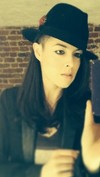The author as human harp. Image: Katherine Templar Lewis
Digital technology is blurring the line between musician and listener. The instrument? You.This is the theme of the Reverb festival, currently at the Roundhouse in London. The event is curated by musician Imogen Heap, who described its mission as to "smash the fourth wall down—the unseen barrier between stage and audience" and invite the public to "take part and be the music."So it is I find myself attached to the metal architecture of the Roundhouse itself. Five leashes extend from a metal scaffold clip to a beautiful leather harness strapped around me. The natural tone of a piano hammer strikes the metal above and each note is recorded and modulated in real time in response to my movement. The angle, speed and distance of my motions are all picked up by a rotary encoder and played back, creating an ethereal and industrial soundscape particular to my body's movement around the structure.I am a Human Harp. I have become a "movician," a moving musician, and it's a unique and rather wonderful experience.The term "movician" was coined by the creator of the Human Harp, Di Mainstone, though it could be used to describe participants in all of the instillations showcased at Reverb. In each one, the body of an audience member modulates or affects the sound created. Audience is participant; participant is creator.What interests me most about the installations is their ability to translate one medium into another. Mainstone described to me her desire to use technology to "change the function of architectural structures, making the invisible audible in a way that is poetic"—hence it is motion and space that become sound in the Human Harp.Another instillation that aims to translate movement into sound is Felix's Machines Triptych, which will be on show later this month. Creator Felix Thorn uses everyday objects to create a 3D visual and audio show. Past "machines" have included the Moleskine Orchestra, in which diaries were used as clappers and glasses as drum sticks to create a multisensory display. In the triptych, rhythmic loops of sound will be triggered and altered by the proximity of the observer to the machines, which will perform faster when the viewer is closer. Again, the observer, wittingly or not, becomes musician.Meanwhile, artist collective Wintour's Leap show that art and music aren't mutually exclusive. In their piece Helmholtz, audio becomes visual in a split second. A giant lattice of 200 LEDs spread around the space ripples with waves of light. Each one, spaced a metre apart from the next, has its own microphone attached.The LED brightness increases with proximal sound level, visualising the sound as it moves around the room. Thus the pattern, speed and intensity of the lights in the lattice is triggered and altered by the sound of anyone who enters the space, from whisper to footfall. Conscious of the effect of my every sound and movement, I find myself walking around with perfect posture and thinking carefully before I speak. Visitors are encouraged to be as experimental as possible, even bringing their own musical instruments along.The beauty of the human instrument is that you don't need a musical background to become a composer—a "movician." That said, there are also a series of performances throughout the festival by actual musicians who are embracing this kind of technology.The festival will culminate in the live premiere of Imogen Heap's new album Sparks, featuring a performance with her gestural glove system. The gloves, developed by MiMu, use software developed by Ableton along with Microsoft Kinect motion capture data systems to translate minute movements into sound, creating an "experimental gestural vocabulary." They work wirelessly and not only translate Heap's gestures but also her position on stage. The user interface allows her to switch between different sonic "modes," changing the sound produced.LEDs on the gloves give both her and the audience a frame of reference as she herself becomes a "movician." Like the Helmholtz light show, the result is a visual as well as audio performance. The future of music looks as exciting as it sounds.
Advertisement
Advertisement
